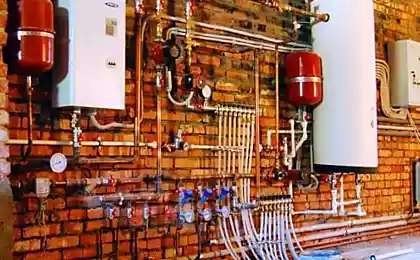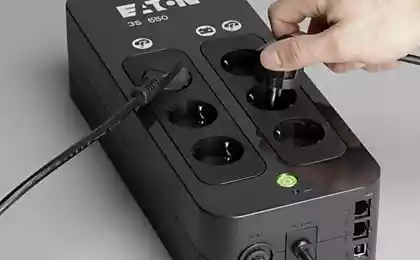850
Operating experience of Uninterruptible Power Systems with solar panels in the "summer" conditions
Alternative "clean" energy, for which, no doubt, the future, in some cases, it may be natural and practical choice now. First, in cases where it is necessary to provide a low-power electricity consumer located "in the open field." A private house, if everything is selected and constructed taking into account the requirements of energy saving (and you will, for example, do not plan to use electricity for heating) is just an example of such a "low-power" user. Yes, in contrast to the apartments, there are added also, as a rule, borehole pumps for independent water supply and various gardening equipment, but you ask for, it is actually powered it all from the solar system, supplemented by wind generator and a safety net - some gas or diesel generator. And the latter will be included rarely, if all calculated correctly.
And it can be cheaper than the power lines connected to on an individual basis. Therefore, in the Russian context, perhaps the lack of a "collective" power is the most common cause of interest in alternative power sources. But in my opinion, there is at least one more argument in favor of "green" systems, where it is sunny, even if there is "public" 220.
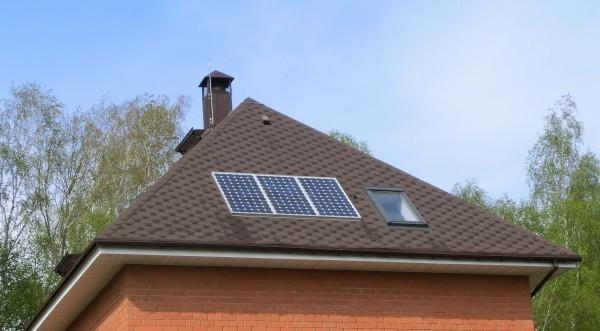
The fact that the stability of supply, even in the suburbs, outside the city can leave much to be desired. And in the case of my holiday village bottleneck is winding the neighboring forests from village to village high-voltage line. Trees, alas, fall from the wind, and this is not known, it seems, only those who believe normal laying of overhead lines in wide glades on the strength of ten meters. But perhaps, cabling in the ground more than the periodic replacement of poles affected by the neighboring pines. And all this is counted wise.
I would like to believe, but it does not work, because there is visible through the Russian tradition: first make koe-kak, but cheaper, and then spend time and resources on patching holes (and sincerely surprised: why a new money is not enough?). Accordingly, to make better and more expensive "first" to save "later" - a much easier privately
. And since some time in the season is the "good" storm, after which the line to lift out a week or even longer, not counting the more short-term outages, longed to get your own supply of autonomy. Ideally - such that do not notice all this mess. Diesel or petrol variant was dropped almost immediately, we even bought that. But the desire to drive this howling and stinking miracle of technology, came to enjoy the contact with nature, it was lower than the actual demand for electricity. It is better to do candles or leave the city. Accordingly, this issue has gained urgency when it wanted to live in a house on a more or less permanent basis.
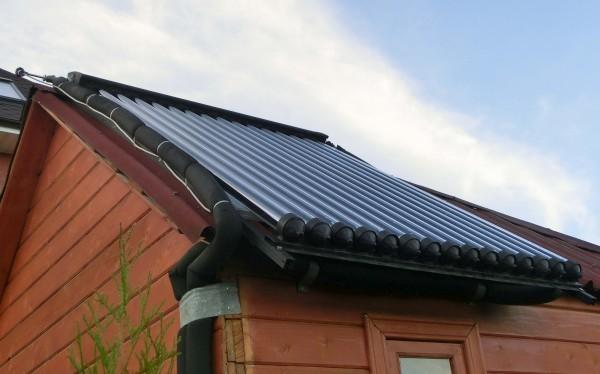
Meanwhile, the feature of the summer home that mass activity was going on in the summer, when solar power, even at the latitude of Moscow, more than enough. Actually, some trees fall mainly in summer. It usually was, the storm had passed, the sun is shining and there is no electricity. And interest in the "solar" energy has been supported by the purchase of a solar collector to heat the water. In particular, compact enough (12 tubes for 1, 8 m) confidently cope with the task of extending the "bathing season" in the 12-cc basin for about a month, compared with the natural heat.
So about a year ago, the system has been assembled, of which I want to tell. Special attention is paid to history, not to engage in a discussion on the profitability of solar systems compared to traditional. Sometimes, as we have seen, there are arguments in addition to the cost of a kilowatt.
We turn to the choice of components for solar systems.
Solar panels
Let's start with solar panels. In order to reduce the effectiveness and cost of the battery followed by monocrystalline, polycrystalline and amorphous silicon. The vast majority of brand batteries are the first type, which in itself is considered to be the most durable of all the cells are degraded more slowly.
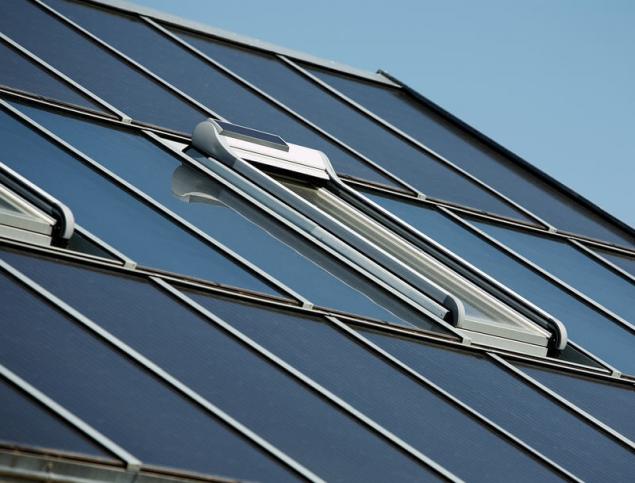
Incidentally, if the house is small, and you do not have any conveniently located with a large barn south slope, in practice you may find that space for the batteries is not so much. And it makes sense to take the model with the highest efficiency per unit area, if you really want to build a system with sufficiently high energy efficiency. Since it is necessary to place batteries on the southern slope of the roof, preferably at an angle of 45 degrees.
By way of installation has a battery mounted in the roof in the manner of roof windows (actually only Roto company with a completely insane cost). And the rest is a simple majority of the panel, built into an aluminum frame, which are attached to the overhead rails. last downside is that the roof has to be drilled, and not every coating will withstand a gross interference without leakage. However, this is the only way the option that was selected.
As for the battery, then a good option in terms of price and quality were Zelenograd monocrystalline battery. Yet enough of them are willing to buy in Germany. Therefore, while in Russia, it is logical and even nice to be able to use at least something related to electronics, but local production.
three batteries (TCM-170B) with a capacity of 170 watts and the size of 158 × 82 cm were purchased in this case the calculation was simple:. obtain sufficient charge current in cloudy weather, as well as morning and evening, to the energy balance, the minimum, allowed one run refrigerator indefinitely. Since the consumption of the refrigerator - about 100-200 watts, and it works intermittently, such a load of this variation is quite capable -. Of course, if the buffer battery
In the real world, when the sun is still shining, and people live in the house, the energy should be enough, and the fact that the use of household appliances, to pump water, and so on. E., Even during prolonged absence of an external power supply. No frills, but no special saving mode. Anyway, I hoped, and now I can confirm that the payment was justified.
Solar Controller
Standard voltage of solar panels and the voltage required to maintain the battery charge is not the same. Rather, the output voltage of the solar panel varies from zero to maximum depending on the light, and there can not do without an intermediate conversion.
In the simplest case, a controller is needed, which would cut off the batteries when their charge reached a maximum, and is connected back when, firstly, needs to be recharged, and, secondly, the output voltage of the solar array to match the required normal charge. But this is a very inefficient method.
Therefore, the PWM modulation modern yet affordable controller that allows you to get an acceptable voltage and current to charge a larger input range. The drawback here is that you still need at least roughly to combine the output voltage of the solar array panels to the array voltage batteries.
Finally, the most versatile and efficient method of offering MPPT-controllers that are able to convert the voltage to a much greater range and while the track the maximum power point, and thus allow you to catch the maximum energy charging and to ensure the early morning and before dusk. In my case the version with controller was the only adequate, since the three solar panels, as they are no Band, gave a non-standard voltage. Well, with the controller - can be connected in series, and that it is more convenient (less cables), and less transmission loss, since the same power is transmitted at the maximum voltage and therefore less current. This is also important if the home is high, and from solar panels to the rest of the electronics and the battery will be ten meters of cable, or even more.
Perhaps the most famous and popular MPPT-controllers - MorningStar production. The selected model TriStar-MPPT-45 is designed for the charging current of 45 A, which is of course superfluous (but low-power MPPT-controllers hardly find, and to the same NEC requirements imply a margin of 25% for current, ie the actual permissible current is obtained not more than 36 and, and, roughly speaking, such a charge controller, battery pack can be over 360 Ah). The battery voltage battery can be arbitrarily chosen from the group of 12, 24, 48 and 36 V. Finally, the input voltage from the solar panels should be in the range of 150 V. Of course, with such characteristics mate is not the slightest problem
Inverter Charger + device
Connect the battery with the battery, it is logical to think about the second half of the circuit, that is, we need to be able to feed from the battery to an external network, and charge them on this same network.
In the most general case we need an inverter, a charger, and a relay which switches the load to the disappearance of the input voltage. Fortunately, there are models of inverters, where all these functions are combined, which is important if we want to achieve a fully autonomous and maintenance-free operation - since the individual inverters often require manual restart after they ran out of battery life and the disabled, etc. <.. br>
Actually, the algorithm of the need to pay attention to when choosing a universal device. It is important that it is automatically started to charge the battery after the appearance of the supply voltage. It is also important that the load disconnection voltage for the inverter was put up solar controller off voltage. In this case, the batteries will be recharged at once: either as "will talk", or when the morning comes. Even if the batteries sit in the evening.
Since the quality inverters models usually have a 2-3-fold margin of the starting current, and it is not an emergency, namely the regular mode of operation, quite correctly select the nominal power according to the actual maximum that you may need. This is usually enough to lay down power downhole pump in a steady mode of operation and power of the refrigerator compressor, and add 20-30% of the stock to "bulb" and other everyday small things, that you are ready to connect to the backup line.
Yes, of course, it assumes that the backup line is laid using a separate cable, and plug it makes sense to identify so that they do not accidentally turned included some iron. Generally, the "work" to ensure the simultaneous load as low as possible, it is meaningful primarily for battery resource. As is known, if the discharge current is greater than the optimum for the battery, its real capacity can be substantially less than stated. And it's not in our interest.
In my case it turned 700 + 200 V · A "must exactly." And given the fact that the pump may eventually be required and more powerful, for the backup line was optimal to choose a model with a capacity of 1500 within the VA.
After a very brief reflection, I chose Outback GFX1424E. This model is certainly a little expensive for its facilities in 1400 · A. But, as I said, chasing power in the case of inverters for home emergency line is meaningless. Hardly anyone will put the appropriate battery pack to actually be able to load their 2-3 kilowatts load. Much more interesting in this case to pay for additional features and, of course, quality.
The latter is particularly important, given that the device will be working around the clock and in a separate room without supervision. What exactly attracted to the device:
Made in the USA. It so happened that as a synonym for reliability techniques phrase used often "German quality". Meanwhile, American products more often and stronger and longer serves as the technological level of the country, at least not inferior, but there is no austerity in the materials as in Europe.
Hermetically sealed. Accordingly, the device is protected from dust, moisture and insects. No, in the house, of course, is pure, but in the rooms to put a rack with electrical engineering is hardly reasonable - better suited for that garage or basement. And the device the usual layout with ventilation grilles necessarily nasoset your fan dust - if not immediately, but after a year or two for sure. It is possible that some spider arrange emergency earlier :)
Low noise levels. The inverter is not exactly quiet: high-frequency squeak in some modes there as well, in spite of the sealed case, playing the role of a radiator, inside there are low-speed fan that turns on and sometimes surpasses the air from the hotter components to the radiator. But even at maximum load (that is actually in standby mode), the noise does not exceed 40 dBA, while in standby mode when the battery is charging, and the ambient temperature exceeds 25 degrees - no more than 35 dBA. It is very small, the majority of desktop computers during louder noise, well, classic inverters with fans -. Certainly noisier
Low power consumption (18 watts in idle mode, 6 W in StandBy mode). Here it should be borne in mind that the use hibernation mode, you will be able to, if the house is no low-power energy consumers need constant nourishment. The most common example of such a consumer - protection system (alarm)
. Pure Sine Wave. Formally, even sensitive to the shape of the power supply apparatus capable of largely tolerate an approximate sine wave. Anyway, in the case of engines - in view of the fact that the emergency power mode, they will work only a fraction of the time. But, of course, the correct form of sinus - this is a feature that is worth to pay. Rather, there are concerns on the reverse: inverters with the approximation of the market occupied by the lowest (initial) segment, and they have many shortcomings purely structural properties, besides the form of voltage. Here to stay for such products expect naively.
But the most curious feature that finally tilted in favor of the choice of this device - the ability to export electricity. In other words, when the battery is fully charged, turn on the inverter, and the excess energy coming from the solar panels (or other alternative sources connected to the low voltage circuit circuit, parallel batteries), is sent to an external circuit. Accordingly, the first compensated by domestic consumption, and if there is still, and for the neighbors, it is possible to observe how the meter is spinning in the opposite direction. This, of course, it is nice, because it is only for the sake of redundancy to collect such a system is not very interesting (yet most of the time outside the network is working). But why not use their energy?
I should add that even semi-detached from the charger, not all inverters have an export function. And if you collect system from individual components, have to buy an additional controller and even, perhaps, to tinker with programming and configuration. There is already a sense in such piping is only on the condition that you have collected quite a serious alternative power.
In this case, I do not quite been sure that everything will turn automatically. Yet solar controller is taken from another manufacturer, and both devices include programming (an inverter attached a separate socket and solar controller is connected via COM-port). And again there is a choice of the threshold voltage for charging batteries and export regime.
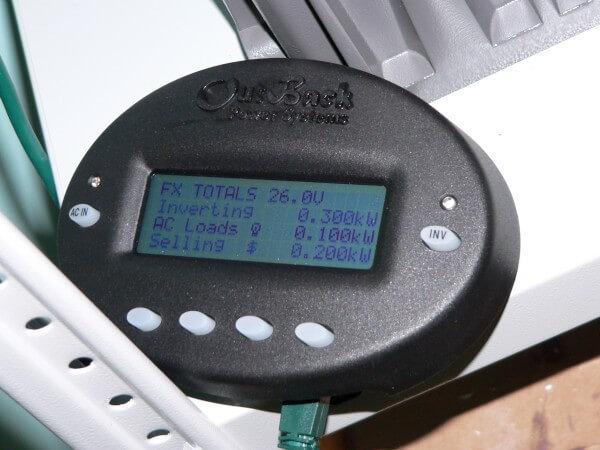
However, since the assembly of the entire system lasted past midnight, I put the configuration and programming of the night. And in the morning it was discovered that the battery charge is over, and because the house is nothing serious at this point was not included, the counter is really cool in the opposite direction. Everything worked as it should.
About the measurements, which failed to do, I have more to say at the end; add only that the ability to export tested using an electromechanical meter, which is easily distinguished by a rotating disk. Electronic are currently not work as it should, that is, the current will give you, but only for charitable purposes. In the meantime, have a few words to say about the choice of batteries.
Batteries
For the construction of independent power home systems usually used lead-acid batteries closed. The so-called VRLA - Valve Regulated Lead-Acid, that is valve-regulated gas emissions. Существуют два типа таких аккумуляторов: AGM (Absorbed Glass Mat), в которых электролит между пластинами находится в стеклопластиковых капсулах, и гелевые. В последнем случае в электролит добавляются загустители, и при производстве аккумулятора этот электролит намазывается на пластины.
И если в компактных источниках бесперебойного питания чаще используются гелевые аккумуляторы, то для систем большой емкости в настоящее время самыми популярными являются AGM-модели, которые и были выбраны.
Поскольку бюджет был отнюдь не резиновый, были взяты два аккумулятора бюджетного производителя Leoch DJM12-200 емкостью 200 А·ч каждый.
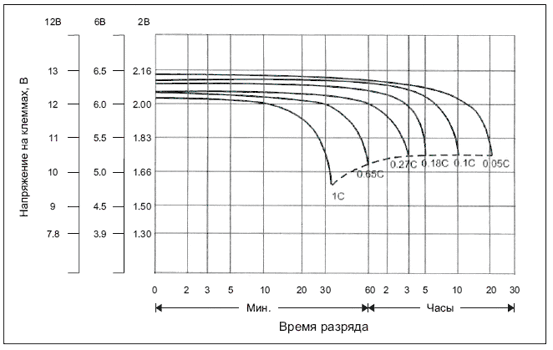
Такой большой запас необходим для того, чтобы кратковременная нагрузка высокой мощности (насос) создавала, тем не менее, ток в пределах благоприятного режима для аккумуляторов. Как мы видим на диаграмме, для того чтобы время резервирования действительно составляло часы, а не минуты, желательно, чтобы ток в низковольтной цепи не превышал 0, 2C (то есть пятую часть емкости). Аккумуляторы были соединены последовательно, поскольку инвертер был выбран с поддержкой 24-вольтовой цепи, и это также благоприятно для снижения потерь в соединениях.
Соединяем в систему
Здесь все достаточно тривиально: общее правило — минимизировать длину низковольтных цепей. Поэтому инвертер, солнечный контроллер и аккумуляторы лучше разместить на одной стойке либо просто рядом.
В моем случае получилось вот так. Провода от солнечных батарей, соединенных последовательно, подключены к солнечному контроллеру (провода имеет смысл взять потолще — от 6 мм², а лучше 10, если дом высокий, а электронику вы собираетесь поместить в подвале). Выход солнечного контроллера, как и выход инвертера, подключены к аккумуляторам, соединенным, в свою очередь, последовательно. В цепь аккумуляторов также необходимо поставить специальный автомат постоянного тока для защиты инвертера и для удобства отключения системы, если это потребуется.
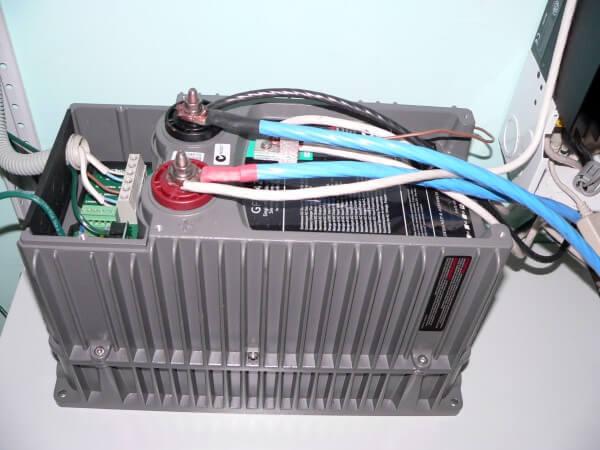
В качестве шин для положительного и отрицательного полюса оказалось удобнее всего использовать выходы инвертера. Сюда же можно подцепить и ветрогенератор и все остальные источники энергии, если увлечение альтернативной энергетикой перейдет в хроническую стадию болезни. Как уже отмечалось, балласт не потребуется и аккумуляторы не перезарядятся — инвертер просто будет отдавать избыточную электроэнергию во внешнюю сеть.
Несколько тестов
В первую очередь надо отметить, что поставленная цель — не замечать кратковременные отключения (на несколько часов) и не особенно менять свои планы на день из-за упомянутой ночной грозы — достигнута полностью. Было и длительное отключение (в пределах недели), когда мы были в отъезде, и раньше бы, несомненно, по возвращении обнаружили разморозившийся холодильник, в морозилке которого всякий уважающий себя дачник хранит часть собираемого урожая. И если бы в цепи не было солнечных батарей, то, разумеется, такой результат не мог бы быть достигнут.
Интересно посмотреть, сколько же фактически вырабатывается энергии при разных погодных условиях. Если замерить мгновенную мощность, когда счетчик стоит, то при условиях, близких к идеальным (температура около 25 градусов, малооблачно, полдень), удается питать нагрузку около 300 В·А. Да, это заметно меньше теоретического заявленного максимума, но упомянутый холодильник от батарей работать сможет, и при этом счетчик продолжает скручиваться, даже в облачную погоду, что уже радует. А ниже — наблюдения в течение одной недели и показатели счетчика.
Выработка, Вт
18 мая (облачно)
730
19 мая (облачно)
750
20 мая (малооблачно)
900
21 мая (солнечно)
1300
22 мая (облачно)
600
23 мая (пасмурно)
220
Итого 4, 5 кВт. Поскольку в доме в это время работали только холодильник, ноутбук и освещение (энергосберегающими лампами, вечером), а также в пределах 30-40 минут в день работал скважинный насос, общее потребление составило 7, 2 кВт. То есть, действительно, почти половину расхода, даже с учетом не самых благоприятных погодных условий, солнечные батареи скомпенсировали.
Хотя, подчеркну, это «побочный эффект», цели сэкономить на электричестве в данном случае не ставилось. Что касается именно вопросов экономии, то если присматриваться к альтернативной энергетике с этой точки зрения, в первую очередь имеет смысл перевести самую затратную статью — нагрев воды — с электричества на некий прямой источник тепла. То есть если уж говорить об экономии и привязывать ее к использованию энергии солнца, лучше начать с простого солнечного коллектора. И если опыт вам понравится, тогда наверняка захочется попробовать еще какой-нибудь источник альтернативной энергии. Поскольку занятие это заразное и увлекательное.
Дополнение
В первую очередь, надо добавить, что никакой опасности «для электриков» устройство в режиме экспорта мощности не представляет. Как нетрудно догадаться, выдача мощности в сеть прекращается при отсутствии внешнего напряжения (а вернее даже — после его снижения относительно запрограммированного пользователем минимального порога). В таком случае инвертер переходит в режим автономной работы и под напряжением остается только резервная линия, и соответственно, только то оборудование, которое вы к ней подключите. За год эксплуатации было довольно много отключений, и к корректности отработки этого состояния, к инвертору претензий нет.
Сами батареи не более нуждаются в обслуживании, чем обычные оконные стекла. Иными словами, если у вас мансардное окно явно своим видом указывает на необходимость мойки, не забудьте протереть и панели. В случае экологически чистого расположения вдали от трасс, по опыту, уборка требуется не чаще раза в год. В конце весны после цветения деревьев. Но в этом году, например, из-за обильных осадков, даже окна мыть не пришлось. Все же, в отличие от вертикальных стекол, наклонные хорошо очищаются дождем. Зимуют батареи у большинства пользователей, которых мне удалось опросить через одну из компаний установщиков таких систем, под снегом, проблем также нет. Хотя, разумеется, если вы планируете снимать напряжение и зимой, то размещать батареи лучше под большим углом или на каком-то поворотном кронштейне, чтобы снег не задерживался.
При выборе инвертора настоятельно рекомендую смотреть спецификации по стартовым токам, они у хороших моделей в несколько раз превосходят штатную мощность. Соответственно, не стоит доверять «ощущениям» или советам тех, кто хочет вам продать оборудование «с запасом». Запас необходим, но рассчитывать его необходимо не по «ощущениям», а по измерениям.
Кстати, буквально на днях сильная гроза опять «удивила» незадачливых подмосковных энергетиков падением сосен. И электричества не было примерно сутки. И как всегда на следующее утро ярко светило солнце, выполняя свою полезную работу.
And it can be cheaper than the power lines connected to on an individual basis. Therefore, in the Russian context, perhaps the lack of a "collective" power is the most common cause of interest in alternative power sources. But in my opinion, there is at least one more argument in favor of "green" systems, where it is sunny, even if there is "public" 220.

The fact that the stability of supply, even in the suburbs, outside the city can leave much to be desired. And in the case of my holiday village bottleneck is winding the neighboring forests from village to village high-voltage line. Trees, alas, fall from the wind, and this is not known, it seems, only those who believe normal laying of overhead lines in wide glades on the strength of ten meters. But perhaps, cabling in the ground more than the periodic replacement of poles affected by the neighboring pines. And all this is counted wise.
I would like to believe, but it does not work, because there is visible through the Russian tradition: first make koe-kak, but cheaper, and then spend time and resources on patching holes (and sincerely surprised: why a new money is not enough?). Accordingly, to make better and more expensive "first" to save "later" - a much easier privately
. And since some time in the season is the "good" storm, after which the line to lift out a week or even longer, not counting the more short-term outages, longed to get your own supply of autonomy. Ideally - such that do not notice all this mess. Diesel or petrol variant was dropped almost immediately, we even bought that. But the desire to drive this howling and stinking miracle of technology, came to enjoy the contact with nature, it was lower than the actual demand for electricity. It is better to do candles or leave the city. Accordingly, this issue has gained urgency when it wanted to live in a house on a more or less permanent basis.

Meanwhile, the feature of the summer home that mass activity was going on in the summer, when solar power, even at the latitude of Moscow, more than enough. Actually, some trees fall mainly in summer. It usually was, the storm had passed, the sun is shining and there is no electricity. And interest in the "solar" energy has been supported by the purchase of a solar collector to heat the water. In particular, compact enough (12 tubes for 1, 8 m) confidently cope with the task of extending the "bathing season" in the 12-cc basin for about a month, compared with the natural heat.
So about a year ago, the system has been assembled, of which I want to tell. Special attention is paid to history, not to engage in a discussion on the profitability of solar systems compared to traditional. Sometimes, as we have seen, there are arguments in addition to the cost of a kilowatt.
We turn to the choice of components for solar systems.
Solar panels
Let's start with solar panels. In order to reduce the effectiveness and cost of the battery followed by monocrystalline, polycrystalline and amorphous silicon. The vast majority of brand batteries are the first type, which in itself is considered to be the most durable of all the cells are degraded more slowly.

Incidentally, if the house is small, and you do not have any conveniently located with a large barn south slope, in practice you may find that space for the batteries is not so much. And it makes sense to take the model with the highest efficiency per unit area, if you really want to build a system with sufficiently high energy efficiency. Since it is necessary to place batteries on the southern slope of the roof, preferably at an angle of 45 degrees.
By way of installation has a battery mounted in the roof in the manner of roof windows (actually only Roto company with a completely insane cost). And the rest is a simple majority of the panel, built into an aluminum frame, which are attached to the overhead rails. last downside is that the roof has to be drilled, and not every coating will withstand a gross interference without leakage. However, this is the only way the option that was selected.
As for the battery, then a good option in terms of price and quality were Zelenograd monocrystalline battery. Yet enough of them are willing to buy in Germany. Therefore, while in Russia, it is logical and even nice to be able to use at least something related to electronics, but local production.
three batteries (TCM-170B) with a capacity of 170 watts and the size of 158 × 82 cm were purchased in this case the calculation was simple:. obtain sufficient charge current in cloudy weather, as well as morning and evening, to the energy balance, the minimum, allowed one run refrigerator indefinitely. Since the consumption of the refrigerator - about 100-200 watts, and it works intermittently, such a load of this variation is quite capable -. Of course, if the buffer battery
In the real world, when the sun is still shining, and people live in the house, the energy should be enough, and the fact that the use of household appliances, to pump water, and so on. E., Even during prolonged absence of an external power supply. No frills, but no special saving mode. Anyway, I hoped, and now I can confirm that the payment was justified.
Solar Controller
Standard voltage of solar panels and the voltage required to maintain the battery charge is not the same. Rather, the output voltage of the solar panel varies from zero to maximum depending on the light, and there can not do without an intermediate conversion.
In the simplest case, a controller is needed, which would cut off the batteries when their charge reached a maximum, and is connected back when, firstly, needs to be recharged, and, secondly, the output voltage of the solar array to match the required normal charge. But this is a very inefficient method.
Therefore, the PWM modulation modern yet affordable controller that allows you to get an acceptable voltage and current to charge a larger input range. The drawback here is that you still need at least roughly to combine the output voltage of the solar array panels to the array voltage batteries.
Finally, the most versatile and efficient method of offering MPPT-controllers that are able to convert the voltage to a much greater range and while the track the maximum power point, and thus allow you to catch the maximum energy charging and to ensure the early morning and before dusk. In my case the version with controller was the only adequate, since the three solar panels, as they are no Band, gave a non-standard voltage. Well, with the controller - can be connected in series, and that it is more convenient (less cables), and less transmission loss, since the same power is transmitted at the maximum voltage and therefore less current. This is also important if the home is high, and from solar panels to the rest of the electronics and the battery will be ten meters of cable, or even more.
Perhaps the most famous and popular MPPT-controllers - MorningStar production. The selected model TriStar-MPPT-45 is designed for the charging current of 45 A, which is of course superfluous (but low-power MPPT-controllers hardly find, and to the same NEC requirements imply a margin of 25% for current, ie the actual permissible current is obtained not more than 36 and, and, roughly speaking, such a charge controller, battery pack can be over 360 Ah). The battery voltage battery can be arbitrarily chosen from the group of 12, 24, 48 and 36 V. Finally, the input voltage from the solar panels should be in the range of 150 V. Of course, with such characteristics mate is not the slightest problem
Inverter Charger + device
Connect the battery with the battery, it is logical to think about the second half of the circuit, that is, we need to be able to feed from the battery to an external network, and charge them on this same network.
In the most general case we need an inverter, a charger, and a relay which switches the load to the disappearance of the input voltage. Fortunately, there are models of inverters, where all these functions are combined, which is important if we want to achieve a fully autonomous and maintenance-free operation - since the individual inverters often require manual restart after they ran out of battery life and the disabled, etc. <.. br>
Actually, the algorithm of the need to pay attention to when choosing a universal device. It is important that it is automatically started to charge the battery after the appearance of the supply voltage. It is also important that the load disconnection voltage for the inverter was put up solar controller off voltage. In this case, the batteries will be recharged at once: either as "will talk", or when the morning comes. Even if the batteries sit in the evening.
Since the quality inverters models usually have a 2-3-fold margin of the starting current, and it is not an emergency, namely the regular mode of operation, quite correctly select the nominal power according to the actual maximum that you may need. This is usually enough to lay down power downhole pump in a steady mode of operation and power of the refrigerator compressor, and add 20-30% of the stock to "bulb" and other everyday small things, that you are ready to connect to the backup line.
Yes, of course, it assumes that the backup line is laid using a separate cable, and plug it makes sense to identify so that they do not accidentally turned included some iron. Generally, the "work" to ensure the simultaneous load as low as possible, it is meaningful primarily for battery resource. As is known, if the discharge current is greater than the optimum for the battery, its real capacity can be substantially less than stated. And it's not in our interest.
In my case it turned 700 + 200 V · A "must exactly." And given the fact that the pump may eventually be required and more powerful, for the backup line was optimal to choose a model with a capacity of 1500 within the VA.
After a very brief reflection, I chose Outback GFX1424E. This model is certainly a little expensive for its facilities in 1400 · A. But, as I said, chasing power in the case of inverters for home emergency line is meaningless. Hardly anyone will put the appropriate battery pack to actually be able to load their 2-3 kilowatts load. Much more interesting in this case to pay for additional features and, of course, quality.
The latter is particularly important, given that the device will be working around the clock and in a separate room without supervision. What exactly attracted to the device:
Made in the USA. It so happened that as a synonym for reliability techniques phrase used often "German quality". Meanwhile, American products more often and stronger and longer serves as the technological level of the country, at least not inferior, but there is no austerity in the materials as in Europe.
Hermetically sealed. Accordingly, the device is protected from dust, moisture and insects. No, in the house, of course, is pure, but in the rooms to put a rack with electrical engineering is hardly reasonable - better suited for that garage or basement. And the device the usual layout with ventilation grilles necessarily nasoset your fan dust - if not immediately, but after a year or two for sure. It is possible that some spider arrange emergency earlier :)
Low noise levels. The inverter is not exactly quiet: high-frequency squeak in some modes there as well, in spite of the sealed case, playing the role of a radiator, inside there are low-speed fan that turns on and sometimes surpasses the air from the hotter components to the radiator. But even at maximum load (that is actually in standby mode), the noise does not exceed 40 dBA, while in standby mode when the battery is charging, and the ambient temperature exceeds 25 degrees - no more than 35 dBA. It is very small, the majority of desktop computers during louder noise, well, classic inverters with fans -. Certainly noisier
Low power consumption (18 watts in idle mode, 6 W in StandBy mode). Here it should be borne in mind that the use hibernation mode, you will be able to, if the house is no low-power energy consumers need constant nourishment. The most common example of such a consumer - protection system (alarm)
. Pure Sine Wave. Formally, even sensitive to the shape of the power supply apparatus capable of largely tolerate an approximate sine wave. Anyway, in the case of engines - in view of the fact that the emergency power mode, they will work only a fraction of the time. But, of course, the correct form of sinus - this is a feature that is worth to pay. Rather, there are concerns on the reverse: inverters with the approximation of the market occupied by the lowest (initial) segment, and they have many shortcomings purely structural properties, besides the form of voltage. Here to stay for such products expect naively.
But the most curious feature that finally tilted in favor of the choice of this device - the ability to export electricity. In other words, when the battery is fully charged, turn on the inverter, and the excess energy coming from the solar panels (or other alternative sources connected to the low voltage circuit circuit, parallel batteries), is sent to an external circuit. Accordingly, the first compensated by domestic consumption, and if there is still, and for the neighbors, it is possible to observe how the meter is spinning in the opposite direction. This, of course, it is nice, because it is only for the sake of redundancy to collect such a system is not very interesting (yet most of the time outside the network is working). But why not use their energy?
I should add that even semi-detached from the charger, not all inverters have an export function. And if you collect system from individual components, have to buy an additional controller and even, perhaps, to tinker with programming and configuration. There is already a sense in such piping is only on the condition that you have collected quite a serious alternative power.
In this case, I do not quite been sure that everything will turn automatically. Yet solar controller is taken from another manufacturer, and both devices include programming (an inverter attached a separate socket and solar controller is connected via COM-port). And again there is a choice of the threshold voltage for charging batteries and export regime.

However, since the assembly of the entire system lasted past midnight, I put the configuration and programming of the night. And in the morning it was discovered that the battery charge is over, and because the house is nothing serious at this point was not included, the counter is really cool in the opposite direction. Everything worked as it should.
About the measurements, which failed to do, I have more to say at the end; add only that the ability to export tested using an electromechanical meter, which is easily distinguished by a rotating disk. Electronic are currently not work as it should, that is, the current will give you, but only for charitable purposes. In the meantime, have a few words to say about the choice of batteries.
Batteries
For the construction of independent power home systems usually used lead-acid batteries closed. The so-called VRLA - Valve Regulated Lead-Acid, that is valve-regulated gas emissions. Существуют два типа таких аккумуляторов: AGM (Absorbed Glass Mat), в которых электролит между пластинами находится в стеклопластиковых капсулах, и гелевые. В последнем случае в электролит добавляются загустители, и при производстве аккумулятора этот электролит намазывается на пластины.
И если в компактных источниках бесперебойного питания чаще используются гелевые аккумуляторы, то для систем большой емкости в настоящее время самыми популярными являются AGM-модели, которые и были выбраны.
Поскольку бюджет был отнюдь не резиновый, были взяты два аккумулятора бюджетного производителя Leoch DJM12-200 емкостью 200 А·ч каждый.

Такой большой запас необходим для того, чтобы кратковременная нагрузка высокой мощности (насос) создавала, тем не менее, ток в пределах благоприятного режима для аккумуляторов. Как мы видим на диаграмме, для того чтобы время резервирования действительно составляло часы, а не минуты, желательно, чтобы ток в низковольтной цепи не превышал 0, 2C (то есть пятую часть емкости). Аккумуляторы были соединены последовательно, поскольку инвертер был выбран с поддержкой 24-вольтовой цепи, и это также благоприятно для снижения потерь в соединениях.
Соединяем в систему
Здесь все достаточно тривиально: общее правило — минимизировать длину низковольтных цепей. Поэтому инвертер, солнечный контроллер и аккумуляторы лучше разместить на одной стойке либо просто рядом.
В моем случае получилось вот так. Провода от солнечных батарей, соединенных последовательно, подключены к солнечному контроллеру (провода имеет смысл взять потолще — от 6 мм², а лучше 10, если дом высокий, а электронику вы собираетесь поместить в подвале). Выход солнечного контроллера, как и выход инвертера, подключены к аккумуляторам, соединенным, в свою очередь, последовательно. В цепь аккумуляторов также необходимо поставить специальный автомат постоянного тока для защиты инвертера и для удобства отключения системы, если это потребуется.

В качестве шин для положительного и отрицательного полюса оказалось удобнее всего использовать выходы инвертера. Сюда же можно подцепить и ветрогенератор и все остальные источники энергии, если увлечение альтернативной энергетикой перейдет в хроническую стадию болезни. Как уже отмечалось, балласт не потребуется и аккумуляторы не перезарядятся — инвертер просто будет отдавать избыточную электроэнергию во внешнюю сеть.
Несколько тестов
В первую очередь надо отметить, что поставленная цель — не замечать кратковременные отключения (на несколько часов) и не особенно менять свои планы на день из-за упомянутой ночной грозы — достигнута полностью. Было и длительное отключение (в пределах недели), когда мы были в отъезде, и раньше бы, несомненно, по возвращении обнаружили разморозившийся холодильник, в морозилке которого всякий уважающий себя дачник хранит часть собираемого урожая. И если бы в цепи не было солнечных батарей, то, разумеется, такой результат не мог бы быть достигнут.
Интересно посмотреть, сколько же фактически вырабатывается энергии при разных погодных условиях. Если замерить мгновенную мощность, когда счетчик стоит, то при условиях, близких к идеальным (температура около 25 градусов, малооблачно, полдень), удается питать нагрузку около 300 В·А. Да, это заметно меньше теоретического заявленного максимума, но упомянутый холодильник от батарей работать сможет, и при этом счетчик продолжает скручиваться, даже в облачную погоду, что уже радует. А ниже — наблюдения в течение одной недели и показатели счетчика.
Выработка, Вт
18 мая (облачно)
730
19 мая (облачно)
750
20 мая (малооблачно)
900
21 мая (солнечно)
1300
22 мая (облачно)
600
23 мая (пасмурно)
220
Итого 4, 5 кВт. Поскольку в доме в это время работали только холодильник, ноутбук и освещение (энергосберегающими лампами, вечером), а также в пределах 30-40 минут в день работал скважинный насос, общее потребление составило 7, 2 кВт. То есть, действительно, почти половину расхода, даже с учетом не самых благоприятных погодных условий, солнечные батареи скомпенсировали.
Хотя, подчеркну, это «побочный эффект», цели сэкономить на электричестве в данном случае не ставилось. Что касается именно вопросов экономии, то если присматриваться к альтернативной энергетике с этой точки зрения, в первую очередь имеет смысл перевести самую затратную статью — нагрев воды — с электричества на некий прямой источник тепла. То есть если уж говорить об экономии и привязывать ее к использованию энергии солнца, лучше начать с простого солнечного коллектора. И если опыт вам понравится, тогда наверняка захочется попробовать еще какой-нибудь источник альтернативной энергии. Поскольку занятие это заразное и увлекательное.
Дополнение
В первую очередь, надо добавить, что никакой опасности «для электриков» устройство в режиме экспорта мощности не представляет. Как нетрудно догадаться, выдача мощности в сеть прекращается при отсутствии внешнего напряжения (а вернее даже — после его снижения относительно запрограммированного пользователем минимального порога). В таком случае инвертер переходит в режим автономной работы и под напряжением остается только резервная линия, и соответственно, только то оборудование, которое вы к ней подключите. За год эксплуатации было довольно много отключений, и к корректности отработки этого состояния, к инвертору претензий нет.
Сами батареи не более нуждаются в обслуживании, чем обычные оконные стекла. Иными словами, если у вас мансардное окно явно своим видом указывает на необходимость мойки, не забудьте протереть и панели. В случае экологически чистого расположения вдали от трасс, по опыту, уборка требуется не чаще раза в год. В конце весны после цветения деревьев. Но в этом году, например, из-за обильных осадков, даже окна мыть не пришлось. Все же, в отличие от вертикальных стекол, наклонные хорошо очищаются дождем. Зимуют батареи у большинства пользователей, которых мне удалось опросить через одну из компаний установщиков таких систем, под снегом, проблем также нет. Хотя, разумеется, если вы планируете снимать напряжение и зимой, то размещать батареи лучше под большим углом или на каком-то поворотном кронштейне, чтобы снег не задерживался.
При выборе инвертора настоятельно рекомендую смотреть спецификации по стартовым токам, они у хороших моделей в несколько раз превосходят штатную мощность. Соответственно, не стоит доверять «ощущениям» или советам тех, кто хочет вам продать оборудование «с запасом». Запас необходим, но рассчитывать его необходимо не по «ощущениям», а по измерениям.
Кстати, буквально на днях сильная гроза опять «удивила» незадачливых подмосковных энергетиков падением сосен. И электричества не было примерно сутки. И как всегда на следующее утро ярко светило солнце, выполняя свою полезную работу.






